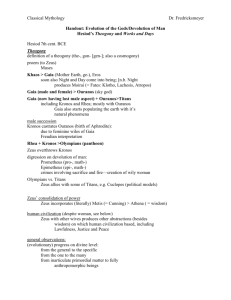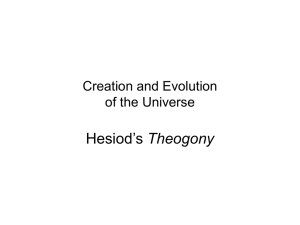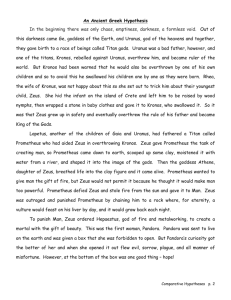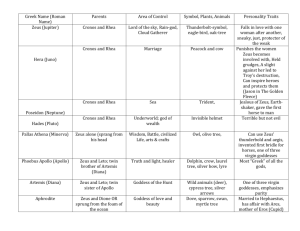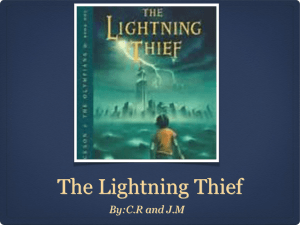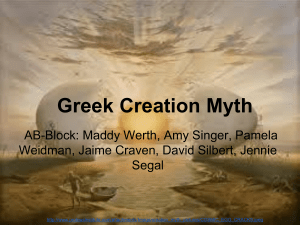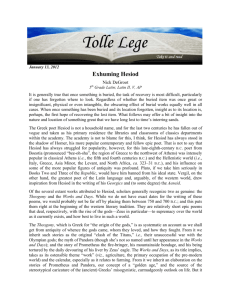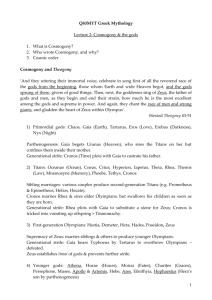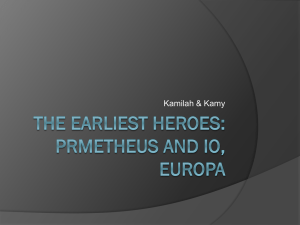Hesiod Powerpoint
advertisement
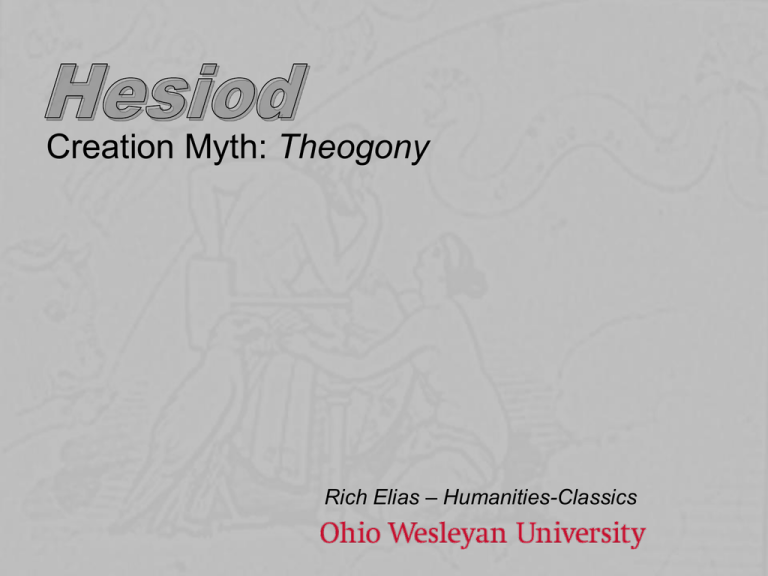
Creation Myth: Theogony Rich Elias – Humanities-Classics Who was Hesiod? • Wrote in ARCHAIC period, c. 750-650 BCE (same period as Homer) • He provides a few details of his life in his poems. For example, he mentions a lawsuit against his brother. • He was a poet who crafted traditional stories about the gods into an organized pattern. Theogony • Means “origin or generations of the gods.” • A cosmogony (= how the universe came to be) and cosmology (= how its parts are arranged) • Names over 300 gods, etc. Delights in catalogs (= folkloric technique). • Figures in the poem range from fully developed characters to allegorical names. Why did Hesiod write it? • Possibly to show off his skill as a poet in a poetry competition. Oral-formulaic composition, memorization, etc. • Nagy: Theogony is an attempt to create a pan-Hellenic myth. Syncretic/syncretism. – Gods from different parts of Greece are organized into a family. • Main theme: the ascent of Zeus as chief god Overall Structure • Invocation of the Muses inspiration • 1st generation: primordial gods: Chaos Gaia Gaia and Ouranos. • 2nd generation: Titans, Kronos, etc. • Interlude: story of Prometheus • 3rd generation: Titanomachy and Zeus’ rise to power. Invocation • Hesiod is a shepherd who seeks inspiration from the Muses (= daughters of Zeus): And one day they taught Hesiod glorious song while he was shepherding his lambs under holy Helicon, and this word first the goddesses said to me -- the Muses of Olympus, daughters of Zeus who holds the aegis: (ll. 26-28) `Shepherds of the wilderness, wretched things of shame, mere bellies, we know how to speak many false things as though they were true; but we know, when we will, to utter true things.' (ll. 29-35) So said the ready-voiced daughters of great Zeus. First Generation • What is Chaos? • Gaia (= Earth) is spontaneously generated. Pay attention to patterns of reproduction!! • Produces children through parthenogenesis, then via sexual intercourse with son/husband Ouranos (= Sky) – Pairing of Earth and Sky a motif in earlier myths of Egypt and the near east. First Generation (cont’d) • Patterns to watch for: – Unusual methods of reproduction – Confused kinship relations – Frustrated reproduction (Ouranos and Kronos) – Monsters dominate here. – Conflict between female and male gods (reflects ascent of patriarchy over matriarchy??) Gaia and Ouranos • Separation of Earth and Sky when Kronos castrates Ouranos = cosmogony – Sparagmos= an ancient Dionysian ritual in which a living animal, or sometimes even a human being, would be sacrificed by being dismembered, by the tearing apart of limbs from the body. • Primal taboo: killing the father • Birth of Aphrodite. Kronos • Meaning of name is disputed. Possibly from Indo-European root meaning “the cutter.” • After he becomes chief god, he swallows his children to prevent them from killing him. Inverts pattern of Ouranos preventing birth by refusing to pull out of Gaia. • Rhea and Gaia conspire to preserve baby Zeus through a scheme to fool Kronos. Kronos (cont’d) • Zeus is taken away and raised in secret (a common motif in mythology. Compare Dionysus, Moses, Jesus, etc.) Prometheus • Does this story really interrupt the genealogical pattern? • It offers an aetiology: why Greeks burned bones as a sacrifical offering to the gods. • Says men already existed but doesn’t explain how or why they were created. • Says women were created as a punishment for mankind. Story of Pandora. (See also Works & Days) Analysis of Prometheus Story • Prometheus punished. On the right, Prometheus Is tied to a column while Zeus' eagle eats his liver. On the left, Prometheus' brother Atlas holds up the sky. Laconian cup, c. 555 BC. Etruscan museum, the Vatican. For a larger (152 K) version, click on the picture. Rise of 3rd Generation • Titanomachy: “Olympians” versus Titans = 3rd generation vs. 2nd generation with help from outcasts from 1st generation. • How does Zeus seek to avoid the fate of Ouranos and Kronos? • Management skills of the Greek gods!! • New regularities: methods of reproduction and kinship relations. Triumph of Zeus • Battle with Typhoios (Typhon), described as the last born child of Gaia. – Circular pattern: 3rd generation defeated 2nd, now defeats 1st. • Assertion of patriarchal order: gods defined in terms of their relationship to Zeus. • Zeus and the Fates.
